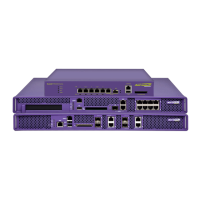Summit WM3000 Series Controller System Reference Guide 221
Viewing and Configuring Bridge Instance Details
The Bridge Instance tab displays the number of MSTP instance created and VLANS associated with it.
To view and configure the MSTP bridge instance:
1 Select Network > Multiple Spanning Tree from the main menu tree.
2 Select the Bridge Instance tab.
CIST Bridge Forward
Delay
Enter the CIST bridge forward delay value received from the root bridge.
If this is the root bridge, the value will be equal to the Configured
Forward Delay.
The forward delay value is the maximum time (in seconds) the root device
waits before changing states (from a listening state to a learning state to
a forwarding state).
This delay is required, as every device must receive information about
topology changes before forwarding frames.
In addition, each port needs time to listen for conflicting information that
would make it return to a blocking state; otherwise, temporary data loops
may result.
CIST Bridge Forward
Delay
Displays the configured forward delay period.
CIST Bridge
Maximum Age
Enter the CIST bridge maximum age received from the root bridge. The
max-age is the maximum time (in seconds) for which (if a bridge is the
root bridge) a message is considered valid. This prevents the frames from
looping indefinitely. The max-age should be greater than twice the value
of hello time plus one, but less than twice the value of forward delay
minus one. The allowable range for max-age is 6-40 seconds. Configure
this value sufficiently high, so a frame generated by root can be
propagated to the leaf nodes without exceeding the maxage.
Bridge Maximum Age
Displays the BPDU maximum age value. If this is the root bridge, the
value will be equal to the Configured Max Age.

